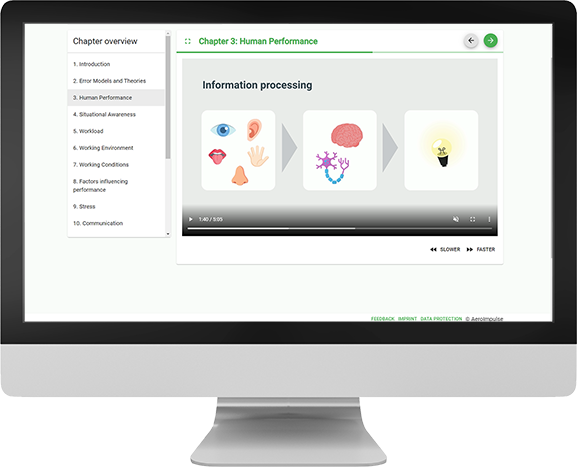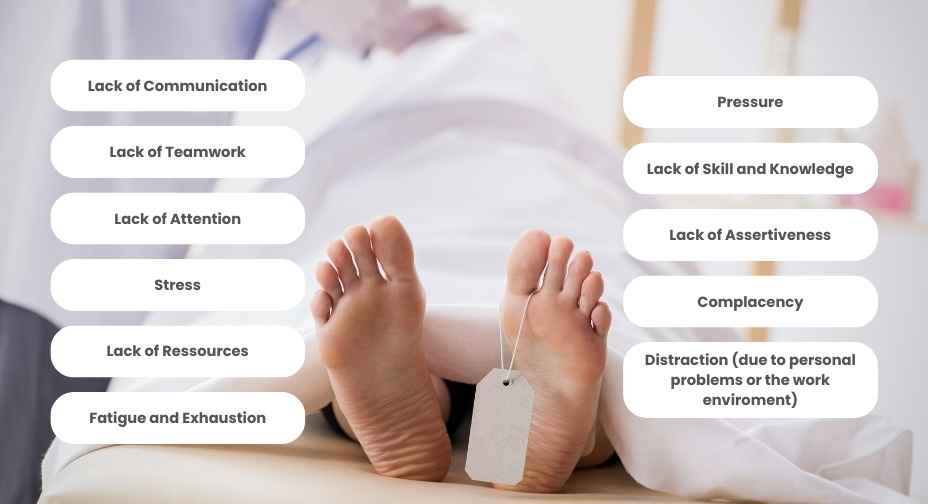CRM Rescue Service / Human Factors Hospital
Learning from mistakes with Human Factors knowledge
It is known from scientific studies that Human Factors are major contributors to about 70 – 80 % percent of all serious incidents in medicine.
Causes of Error – The Role of Human Factors in Medicine
Out of such situations, failure patterns are similar: ineffective communication, poor team interaction, pressure, stress and hectic, social norms (especially strong hierarchies), lack of problem awareness and insufficient assertiveness.
Do you already know our medical Human Factors E-Learning?

- 3.5 hours (Initial), also modular as Refresher
- video-animated training with final test + certificate
- available on all devices
The Dirty Dozen (according to Gordon Dupont):

Comparable incidents also occur in the hospital, rescue service or emergency medicine. Most physicians, EMTs, and nurses will remember similar situations. After all, work environments are similar. Often, similar error patterns and sources can be identified regardless of the industry. The risks are well known, but they fade into the background in daily practice. Some you may dismiss as truisms. But you must also implement these measures if you want to reduce errors caused by Human Factors. In daily practice, implementation requires hard work on oneself and the team, especially when it comes to the self-evident.
Crash of Eastern Airlines Flight 401
The experienced cockpit crew of three had focused on a faulty landing gear indicator and in the darkness had not noticed that they were losing altitude in their holding pattern. The controller, who had noticed the altitude loss, contacted the crew with “Are you okay?” but did not specifically address the altitude loss. By the time the pilots became aware of their misconduct, it was already too late to save the aircraft.
The entire cockpit crew took care of a critical, but not existential problem, neglecting their main task: flying. Not even the air traffic controllers message made the pilots notice their misconduct.
Starting points for avoiding human errors
Against the background of increasing task complexity on the one hand, and more interfaces and more sophisticated technology on the other, the examination of human factors is gaining steadily in importance, especially in medicine.
Human Factors training and CRM training on crisis resource management (like our Human Factors E-Learning) play a key role here.
Do you need support with Error Management?
Get a non-binding offer at info@medicalimpulse.de or
+49 (0)40 5131 5291
Interpersonal skills
- Teamwork
- Communication
- Decision making
- Leadership
- Conflict Management
- Social environment
While technical knowledge is usually well trained and internal processes are at least roughly known, the systematic application of interpersonal skills is usually neglected in training plans. Interpersonal competence is therefore usually not yet sufficiently present in day-to-day operations.
Those involved work too much side by side instead of acting in a coordinated manner as a team. For everyone, such behavior becomes clear in simulation trainings of real cases, in the course of which the participants themselves realize that they do not communicate sufficiently, because essential information is not exchanged among the them. Whether in training or in day-to-day operations, there is rarely wanton restraint involved.
Further helpful Human Factors information!
Are you looking for basic information on Human Factors, Human Error / Dirty Dozen as well as causes of Human Factors accidents? Further helpful knowledge:
- Human Factors – Understanding and mastering human factors. Learn more!
- Human Factors – Causes of Human Error. Learn more!
- That’s basic information, I thought it was known.
- Was it really that important?
- But that was said in the meeting when we were all there.
- The patient did not say this explicitly, but it was clear to me what they meant, even if they did not say it exactly that way.
- I had forwarded the information.
- I recorded that in the patient’s chart, it just wasn’t read by anyone else.
- Oh, I had forgotten to put that in the round.
The magic words here are coordination and teamwork. All stakeholders involved must be willing and able to share their information systematically. Therefore, not only the extroverted, eloquent chief physician may have his say, but also the quiet anesthesiologist or the assistant physician. Good team coordination is characterized by the fact that the operating room nurse can also contribute her many years of knowledge or that the senior physician, who arrives too late, can still have his say with his specialist knowledge. While frequent talkers tend to be slowed down, other team members often have to be explicitly asked to share their knowledge.
Error Culture – sustainably eliminating Human Errors
For the successful implementation of Crisis Resource Management (CRM), it is also necessary to establish an error culture in parallel. In everyday medical practice, errors are often overlooked, ignored or corrected all too quickly. This has the advantage that the focus quickly returns to the actual tasks and the patients. However, this ignores the deeper causes, accumulations or similarities in the error pattern. In such an environment, it is hardly possible to achieve sustainable improvements or learning effects.
However, this kind of thinking is expensive. It leads to errors being corrected, but not their causes. The recurrence of the same or similar errors is therefore only a matter of time. Particularly in medicine, and here in hospitals and rescue services, there must be a working atmosphere in which it is permissible to openly address and discuss errors without “pointing fingers” at people who have behaved incorrectly. A penalizing error culture involves the risk that errors will be concealed and covered up, and in the worst case even repeated due to a lack of communication. Errors must be seen as gaining knowledge for improvement. Management must therefore actively address errors through systematic root cause analyses.